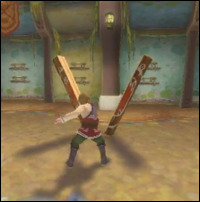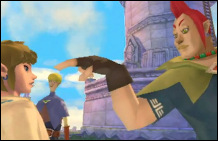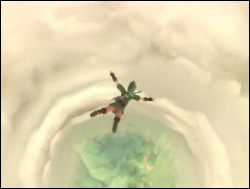Comparing Skyward Sword: Game Introduction
Posted on November 25 2011 by Axle D. Wilder
 It shouldn’t need to be stated that any video game must have an introduction. There are many ways of constructing these early sections of a game, but for a game to have a middle and an end it must have a beginning, regardless of what form that beginning takes. Zelda games are no exception and there have been both good and bad introductory segments throughout the series. Some people have criticized the lengthy introductions found in games like The Wind Waker and Twilight Princess for taking too long getting you into the main game, spending far too much time forcing you to sit there as the game feeds you cutscenes and storyline, while others enjoyed these early portions of the games for their story and style. I find myself between these two opinions, finding both good and bad in these long introductions. I have similar mixed opinions of many introductions throughout the other games in the series.
It shouldn’t need to be stated that any video game must have an introduction. There are many ways of constructing these early sections of a game, but for a game to have a middle and an end it must have a beginning, regardless of what form that beginning takes. Zelda games are no exception and there have been both good and bad introductory segments throughout the series. Some people have criticized the lengthy introductions found in games like The Wind Waker and Twilight Princess for taking too long getting you into the main game, spending far too much time forcing you to sit there as the game feeds you cutscenes and storyline, while others enjoyed these early portions of the games for their story and style. I find myself between these two opinions, finding both good and bad in these long introductions. I have similar mixed opinions of many introductions throughout the other games in the series.
As the latest game in a long-running series, Skyward Sword will inevitably be compared to its predecessors, so I have decided to start doing just that and take a look at many of the core aspects of the series and how Skyward Sword measures up in regards to them. I’ve talked about these elements of the series in detail in past articles, and I will compare Skyward Sword’s performance in these other areas sometime soon. But for now, I will start with the game’s introduction.
The introduction of a game is the beginning of it, as opposed to its middle or end. Like any game’s climax, an introduction often deviates from the bulk of the game in either construction or presentation. As such the introduction, in most cases, probably lasts until you begin doing the standard actions that you’ll find yourself doing in the game; an introduction ends when you begin doing what you’re going to be doing for the rest of the game until the climax. Therefore, Skyward Sword’s introduction, for the most part, ends when you set out from Skyloft to rescue Zelda. Depending on your personal definition of a game’s introduction, however, and especially how you might apply it to the Zelda series, you might say that the introduction lasts until the completion of the first dungeon of the game (which in Skyward Sword’s case, is the Skyview Temple). We’ll examine this from both perspectives.
The game begins with a series of cutscenes that establish the beginning of the game’s mystery, but mainly they establish Skyloft, Zelda, and Link as characters. The content of these scenes, while not overall important in my comparisons to the rest of the series’ introductions, is interesting purely because of two small things. Link is established by watching him wake up, which has happened in a huge number of Zelda games, and additionally how it occurs heavily resembles both A Link to the Past and The Wind Waker. Like in A Link to the Past, Link has a strange dream warning him about mysterious events in which he’s spoken to by his future partner in the game. In Skyward Sword’s dream, Fi speaks to Link, but in A Link to the Past, it is Zelda; A Link to the Past was the first game to introduce the partner mechanic, because mostly Zelda but also Sahasrahla would speak to you through telepathic tiles in the dungeons to give you advice and information. It resembles The Wind Waker because the scene in which Link awakens is handled in a humorous fashion.
 Moving on from that, the game then has Link head on his way to meet with Zelda and then go through a number of other tasks. This section is important, however, not because of those tasks themselves (which I’ll get into later), but because of the tutorials. Like in any Zelda game, Skyward Sword makes sure that the player fully understands how the game works by explaining all of the major mechanics through tutorial sequences and explanations. Some of these are explained or demonstrated by Link’s classmates and instructors at the Knight Academy, while others are taught to Link by Zelda or Fi.
Moving on from that, the game then has Link head on his way to meet with Zelda and then go through a number of other tasks. This section is important, however, not because of those tasks themselves (which I’ll get into later), but because of the tutorials. Like in any Zelda game, Skyward Sword makes sure that the player fully understands how the game works by explaining all of the major mechanics through tutorial sequences and explanations. Some of these are explained or demonstrated by Link’s classmates and instructors at the Knight Academy, while others are taught to Link by Zelda or Fi.
The important thing about Skyward Sword is that, barring Zelda games that lack these explanations entirely such as the NES titles, Skyward Sword handles these learning sections better than any other Zelda game in recent memory. Yes, they are lengthy explanations that may grate on your nerves if you don’t need to learn them, but unlike in most other Zelda games where such explanations are compulsory (even going as far back as Ocarina of Time), in Skyward Sword you can skip the bulk of them. The ones you are forced to sit through are brief and relatively inoffensive, while most of the others you can blatantly walk past or tell the teacher you do not want to hear them (such as with Fi who never forces you into a tutorial explanation unless you consent to it). This will thankfully streamline additional playthroughs, and overall makes the tutorials in the introduction far less annoying for experienced players. In this area, Skyward Sword excels.
When Link goes to see Zelda, a lengthy cutscene occurs and it isn’t the last before you get into the main game. Like The Wind Waker and Twilight Princess, this game forces you into numerous stretches of plot and dialogue between short gameplay sections for a while before you’re completely let loose into the game world. Whether you enjoy or loathe these sections is going to be entirely dependent on how much you enjoy the storyline and character development. Until you locate your bird, most of these sequences develop the characters and their backstory, not the main plot of the game or any of its mysteries. This isn’t inherently a bad thing, but I myself found them to be grating, perhaps even more so than in Twilight Princess, although that’s not actually the fault of the characters and story themselves. In Twilight Princess I enjoyed learning about the characters and the world early on, as I did in The Wind Waker, but those games allowed at least a slight amount of control over the scenes. Skyward Sword is a step backward in terms of dialogue and cutscene control, and there’s honestly no good reason why.
 Skyward Sword does not allow you to skip cutscenes. This is strange considering that a basic skip button is a major element of all modern games, and while Zelda’s rarely had this feature, the last three Zelda games have changed that. Twilight Princess, Phantom Hourglass, and Spirit Tracks all gave you a great amount of control over when you want to skip a sequence, including the lengthy dialogue sections. It’s baffling that this was left out of Skyward Sword. Worse is the lack of control over the text boxes. In most video games these days, and that includes every Zelda game since The Wind Waker, you are able to hold down the “next” button as a dialogue box is filling out to make the text appear faster or to make the box fill out immediately, allowing you full control over the pace you read at, as well as allowing you to mash the button repeatedly to skip many sections of text very quickly, which is nearly as good as being able to skip the scene entirely. None of these features are available at all in Skyward Sword, except the button to make the text appear faster, which barely makes any difference; the text is slow compared to other games.
Skyward Sword does not allow you to skip cutscenes. This is strange considering that a basic skip button is a major element of all modern games, and while Zelda’s rarely had this feature, the last three Zelda games have changed that. Twilight Princess, Phantom Hourglass, and Spirit Tracks all gave you a great amount of control over when you want to skip a sequence, including the lengthy dialogue sections. It’s baffling that this was left out of Skyward Sword. Worse is the lack of control over the text boxes. In most video games these days, and that includes every Zelda game since The Wind Waker, you are able to hold down the “next” button as a dialogue box is filling out to make the text appear faster or to make the box fill out immediately, allowing you full control over the pace you read at, as well as allowing you to mash the button repeatedly to skip many sections of text very quickly, which is nearly as good as being able to skip the scene entirely. None of these features are available at all in Skyward Sword, except the button to make the text appear faster, which barely makes any difference; the text is slow compared to other games.
This might seem like nitpicking unrelated to the design of the introduction, and while this is a qualm I have with the game in general, it makes the storyline sections and all the dialogue of the introduction worse than in any other Zelda game because you have no ability to actually skip any scenes you might not be interested in and you’re forced to progress at exactly the pace the game sets for you. There is no good reason for this – it was an easy fix – and it makes the whole experience far more irritating than it needs to be.
I’ll actually confess that I found Skyward Sword’s introduction only enjoyable to a point until Zelda disappeared. The slow moving and uncontrollable dialogue, the lengthy tutorials (that I did go through for my first playthrough), and only giving me the gameplay in bits and pieces, was a bit grating. The control over the speed of the text would have gone a long way towards improving it, giving the player more control over what’s happening even if they’re not playing. I honestly couldn’t tell you if my main beef with this early portion of the introduction is entirely because of the seemingly small annoyance of the dialogue controls or not. It could be that this is a bigger beef with how little control the game actually gives you over the experience, forcing you into cutscenes and not allowing you to play, and I couldn’t tell you if improving those text mechanics would fix it or not. I will admit the dialogue options were great, though, providing very enjoyable interactions with the characters. This is an element I hope keeps up throughout the game. Elements like this, added to areas of the game that normally lack player control, helps to make them far more compelling.
Once Zelda disappeared and Fi was introduced, however, the storyline and game really took off. After pursuing Fi for a section of gameplay, there is a lengthy cutscene, but the atmosphere of this whole section and the large amount of revelations and story details given out at this point, not to mention the presentation, makes the scene entirely worth it.
 Better yet, as soon as this cutscene ends, you’re free. You can now explore the game world at will. You can enjoy Skyloft’s characters, buy from its shops, and check it out at night, or you can delve into the game’s open world, The Sky, and visit the islands and see what you can do or find. Diving into the green beacon advances you into the next plot area, but if you don’t want to go there or get sick of it, you already have plenty to do. You’ve been introduced to what the game shall normally play like, and thus the introduction is over. Overall, the game does not keep you from this for very long. This is a big step up from the last few games which force you to go through a lot of special gameplay sections and cutscenes before allowing you to play the main game. Skyward Sword gives this to you relatively quickly, aside from the slow-moving dialogue.
Better yet, as soon as this cutscene ends, you’re free. You can now explore the game world at will. You can enjoy Skyloft’s characters, buy from its shops, and check it out at night, or you can delve into the game’s open world, The Sky, and visit the islands and see what you can do or find. Diving into the green beacon advances you into the next plot area, but if you don’t want to go there or get sick of it, you already have plenty to do. You’ve been introduced to what the game shall normally play like, and thus the introduction is over. Overall, the game does not keep you from this for very long. This is a big step up from the last few games which force you to go through a lot of special gameplay sections and cutscenes before allowing you to play the main game. Skyward Sword gives this to you relatively quickly, aside from the slow-moving dialogue.
Extending the introduction to include the Sealed Grounds, Faron Woods, and Skyview Temple does not diminish this in the slightest. The Sealed Grounds has great atmosphere and cool scenes as it pushes you forward on your quest, and your first visit to Faron Woods is no less compelling than a visit to a new area in the middle of another Zelda game. Faron Woods has great gameplay; it is not a gimped introduction area. The same applies to Skyview Temple, which was an interesting dungeon that definitely made use of all the skills learned up to that point.
All in all the introduction of Skyward Sword is a step up from previous games in the series. In concept it’s nearly identical to the introduction of Twilight Princess or The Wind Waker, but it moves at a reasonable pace with enthralling content, thrusting you into the middle of the main game fairly quickly. This process will clearly be heavily streamlined during subsequent playthroughs as I skip explanations and tutorials. It’s a shame they had to fall short of excellence by making the cutscenes and dialogue more irritating than they had to be. Hopefully future Zelda games will renew this functionality, and remember that robbing the player of control is not going to make the player have fun. A video game is fun because it allows you control over the experience, and this should be no different for its introduction. Still, Skyward Sword’s beginning definitely manages to suck you into the game, and I cannot wait to see what else it has to offer.



